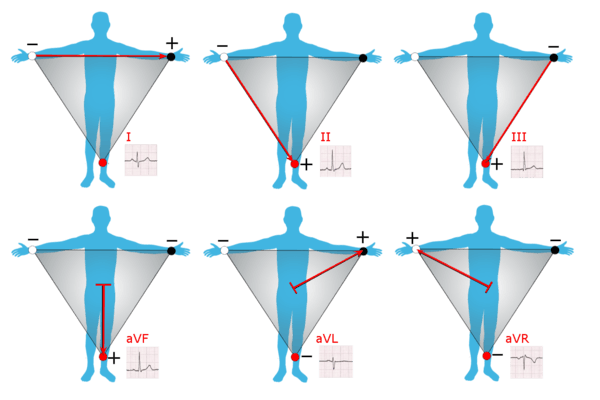Einthoven's triangle

Graphical representation of Einthoven's triangle
Einthoven's triangle is an imaginary formation of three limb leads in a triangle used in electrocardiography, formed by the two shoulders and the pubis.[1] The shape forms an inverted equilateral triangle with the heart at the center that produces zero potential when the voltages are summed. It is named after Willem Einthoven, who theorized its existence.[2]
Einthoven used these measuring points, by immersing the hands and foot in pails of salt water, as the contacts for his string galvanometer, the first practical ECG machine.
Lead placements
- Lead I – This axis goes from shoulder to shoulder, with the negative electrode placed on the right shoulder and the positive electrode placed on the left shoulder. This results in a 0 degree angle of orientation. [3]
- Lead II – This axis goes from the right arm to the left leg, with the negative electrode on the shoulder and the positive one on the leg. This results in a +60 degree angle of orientation. [3]
- Lead III- This axis goes from the left shoulder (negative electrode) to the left leg (positive electrode). This results in a +120 degree angle of orientation. [3]
References
- ↑ Lippincott Williams & Wilkins (1 August 2009). ECG Facts Made Incredibly Quick!. Lippincott Williams & Wilkins. p. 5. ISBN 978-1-60547-476-2.
- ↑ Understanding Electrocardiography. Elsevier Health Sciences. 2003. p. 4. ISBN 0-323-01905-6.
- 1 2 3 The Only EKG Book You'll Ever Need. Lippincott Williams & Wilkins. 2003. p. 40. ISBN 0-7817-4176-9.
This article is issued from Wikipedia - version of the 10/28/2016. The text is available under the Creative Commons Attribution/Share Alike but additional terms may apply for the media files.